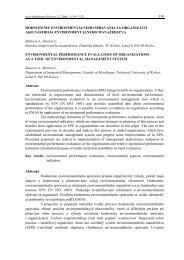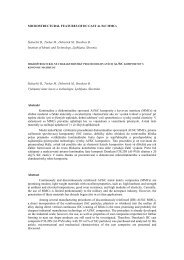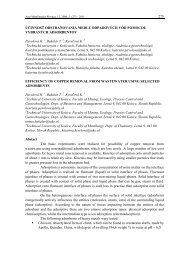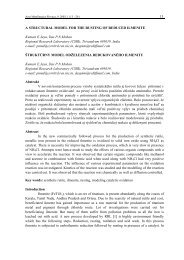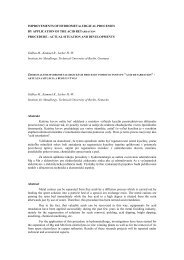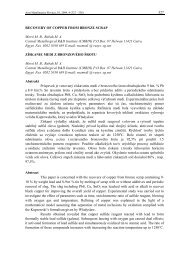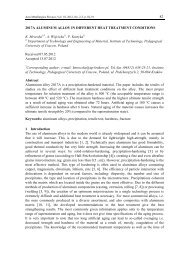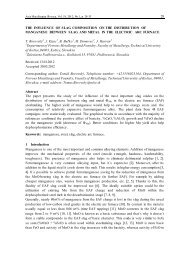mag14.pdf (220 kB) - Acta Metallurgica Slovaca
mag14.pdf (220 kB) - Acta Metallurgica Slovaca
mag14.pdf (220 kB) - Acta Metallurgica Slovaca
You also want an ePaper? Increase the reach of your titles
YUMPU automatically turns print PDFs into web optimized ePapers that Google loves.
<strong>Acta</strong> <strong>Metallurgica</strong> <strong>Slovaca</strong>, 11, 2005, 3 (369 - 374) 369COMPARISON OF ELECTROCHEMICAL CORROSION PROPERTIESOF SELECTED LEAD-FREE SOLDERSLasek S. 1 , Drápala J. 2 , Urbaníková Ž. 2 , Blahetová M. 11 Department of Materials Engineering, 2 Department of Non-ferrous Metals, Refining andRecycling, Faculty of Metallurgy and Materials Engineering, VSB-Technical University ofOstrava, 17. listopadu 15, Ostrava-Poruba, 70833, Czech Republic, Stanislav.Lasek@vsb.czPOROVNÁNÍ KOROZNĚ ELEKTROCHEMICKÝCH VLASTNOSTÍ VYBRANÝCHBEZOLOVNATÝCH PÁJEKLasek S. 1 , Drápala J. 2 , Urbaníková Ž. 2 , Blahetová, M. 11 Katedra materiálového inženýrství, 2 Katedra neželezných kovů, rafinace a recyklace, Fakultametalurgie a materiálového inženýrství, VŠB-Technická univerzita Ostrava, 17. listopadu15/2172,Ostrava-Poruba, 70833, Česká republika, Stanislav.Lasek@vsb.czAbstraktKorozně elektrochemické vlastnosti vybraných bezolovnatých pájek (Sn99Cu1;Sn95Sb3,5Cu1,5; Sn95Sb5; Sn95,5Ag3,8Cu0,7; Sn96Ag4) a téměř eutektické Sn67Pb37 slitinyjsou porovnány na základě potenciodynamické polarizační metody (voltammetrie) s použitímvodného roztoku 0,1 mol/l KOH za normální teploty. Uvedené slitiny byly zkoušeny ve tvarudodaných drátů anebo tyčí. Poměrně malé rozdíly byly zjištěny mezi bezolovnatými pájkami vhodnotách korozních potenciálů, pasivačních proudových hustot a v šířce aktivní oblasti.Všechny tyto pájky vykazovaly aktivně-pasivní přechod. Značné rozdíly byly zjištěny mezianodickými polarizačními křivkami bezolovnatých pájek a pájkou Sn63Pb37. Více anodickýchpíků bylo zaznamenáno na polarizačních křivkách Sn-Pb pájky, kde přechod do transpasivníoblasti probíhal při nižších hodnotách potenciálu, než u bezolovnatých pájek. Rychlost koroze(podle proudové hustoty) v aktivním stavu byla vyšší na pájkách s obsahem antimonu, zatímco vpasivní oblasti tato rychlost byla významně vyšší pro pájku Sn-Pb. Měď a stříbro v malémmnožství se prakticky neprojevily na korozních vlastnostech v aktivní oblasti, avšakv transpasivní oblasti způsobily zvýšení proudové hustoty a vznik menších píků. Poprovedených elektrochemických zkouškách byla pozorována na povrchu pájek rovnoměrnákoroze. V příspěvku jsou také uvedeny výsledky chemické mikroanalýzy zkoušených pájek,včetně jejich minoritních fází a oblasti hranic zrn. Rovněž jsou porovnány základní vlastnostizkoušených pájek (rozmezí teplot tavení, povrchové napětí, tvrdost, hustota).AbstractElectrochemical corrosion properties of lead-free solder alloys (Sn99Cu1;Sn95Sb3,5Cu1,5; Sn95Sb5; Sn95,5Ag3,8Cu0,7 and Sn96Ag4) and near eutectic Sn67Pb37 oneare compared in the 0,1 mol/l KOH water solution at room temperature on the base ofpotentiodynamic polarization method (voltammetry). These tin alloys were tested in the form ofas-received wires and rods. Relative small differences were found out in corrosion potentialvalues, passivation current densities and active peak width among these lead-free alloys. Allthese solders exhibit active–passive transition. There were registered significant differencesbetween anodic polarization curves of lead-free and Sn-Pb solders. More anodic peaks were
<strong>Acta</strong> <strong>Metallurgica</strong> <strong>Slovaca</strong>, 11, 2005, 3 (369 - 374) 370measured on the Sn63Pb37 solder, where transition to the transpassive region started at lowerpotential values in comparison with lead-free solders. Corrosion rate (according to currentdensity and peak) was higher on Sb containing solders in the active state, on the other hand inthe passive range the corrosion was higher for Sn-Pb one. The corrosion properties were notinfluenced by copper and silver in small quantity in the activity area, but in the transpassivityarea they caused small peaks and current density increasing. The uniform corrosion wasobserved after potentiodynamic polarization tests. The results of chemical microanalysis ofsolders, including secondary phases and grain boundary areas are also given in the contribution.The main properties of tested tin solders (melting temperature range, surface stress, hardness,density) are compared too.Key words: Tin alloys, lead-free solders, electrochemical corrosion, potentiodynamicpolarization method.1. IntroductionTin is widely used as a protective coating for steel plates and for mild solders. Thenew types of lead-free solders have been developed and recommended for replacing Sn-Pbsolders mainly for health and ecological requirements. Anodic behaviour and corrosion of tinbase alloys under different conditions has been studied by electrochemical methods.The formation and chemical composition of passivation layers on Sn and Sn-Cualloys have been systematically studied in 0,1M KOH with potentiodynamic method and X-rayphotoectron spectroscopy (XPS) [1]. The potentiodynamic polarization curve of pure tin has twoanodic peaks at potential E = -1,05V and E = -0,75V (SCE), which agree reasonably well withthe formation of soluble HSnO 2 - and SnO 3 2- . A large passive range (with film or layer thickness≤5 nm) follows between -0,5 and 1,2V with lower current density J = 0,02mA.cm -2 and asecondary passive range up to 1,9 V with an increased current density 0,2mA.cm -2 . At E >1,9 Vfollows a steep current increase attributed to oxygen evolution. The cathodic peak at E = -1,25V is comparatively small which allows two explanations: only a very small amount oxide hasbeen formed on the electrode or the reduction of the passive layer at this peak is not complete.The passive layer on tin consists of SnO/Sn(OH) 2 film in contact with the electrolyte followedby inner part of SnO 2 /Sn(OH) 4 and Sn(II) fraction at the oxide/metal interface.The electrochemical behaviour, microstructure and corrosive products of Sn-Zn9-Agxlead-free solders were investigated in study [2]. The Sn63-Pb37 and Sn-Ag3,5 solder alloyswere also tested for comparison. The Sn-Ag3,5 solder alloy had higher equilibrium potential (-0,44 V SCE) than the ones Sn63-Pb37 (-1,10 V) and Sn-Zn9 (-1,43 V). The Ag additionenhanced the corrosion resistance of the Sn-Zn9 solder alloy. Passivation behaviour occurred inthe solder alloys used [2], except the Sn63-Pb37 one. X-ray diffraction patterns showed that theZn segregated in the Sn-Zn9 solder alloy as solidified, but it dissolved when 0,5% wt Ag wasadded to the solder alloy. The AgZn 3 and Ag 5 Zn 8 were found in the Sn-Zn9-Ag1,5 solder alloybut they were substituted by Ag 3 Sn when the Ag content in the solder was above 2,5 % wt.However, they are the initial sites for pitting. The corroded product of SnCl 2 was observed in allsolder alloys tested. The potentiodynamic polarization method is applied for the corrosion studyof lead-free solders in further studies [3,4]. The Sn-Pb base solders are used for the comparisonpurposes.The aim of this contribution is the comparison of corrosion electrochemical propertiesof selected lead-free solders on the base potentiodynamic polarization method.
<strong>Acta</strong> <strong>Metallurgica</strong> <strong>Slovaca</strong>, 11, 2005, 3 (369 - 374) 3712. ExperimentalThe chemical composition of tested solders is given in Tab.1. The microanalysisresults of their selected phases and grain boundary segregations are documented in the work [5]as well as structures. The solders were made in KOVO Příbram and in Department of NonferrousMaterials, Refining and Recycling, VSB-TUO by technology of casting and forming intorods and wires.Table 1 Chemical composition of tested soft solder alloys [weight % ]solder / element Ag As Bi Cu Fe Pb Sb Sn1 Sn99Cu1 0,0004 0,015 0,004 0,75 0,006 0,04 0,02 rest2 Sn95Sb3,5Cu1,5 0,0025 0,005 0,007 1,40 0,022 0,060 3,3 rest3 Sn95Sb5 0,0002 0,001 0,012 0,017 0,014 0,029 4,9 rest4 Sn95Ag3,8Cu0,7 3,75 0,001 0,007 0,74 0,010 0,03 0,02 rest5 Sn96Ag4 3,73 0,007 0,007 0,005 0,009 0,028 0,01 rest6 Sn63Pb37 0,0003 0,001 0,009 0,001 0,003 rest 0,008 62,9The content of other elements: Al
<strong>Acta</strong> <strong>Metallurgica</strong> <strong>Slovaca</strong>, 11, 2005, 3 (369 - 374) 372corrosion software was used for the technique mentioned above. All measurements wereperformed at constant temperature 25±1°C.3. Results and discussionFig. 1 shows potentiodynamic curves of Sn99Cu1, Sn95Cu1,5, Sn95Sb5 solder in 0,1 M KOH at 253J [ mA/cm 2 ]21E [mV]Fig.1 Polarization curves of lead-free solders: 1- Sn99Cu1, 2 - Sn95Sb3,5Cu1,5, 3 - Sn95Sb5The anodic polarization curve exhibits active/passive transition, similar as in the caseof clean tin [1] with characteristic peaks. The active dissolution region involves a well-definedtwo anodic peak for alloy Sn99Cu1, followed by a passive region, which extends up to 1,0 Vwith almost constant current density, which is further rising by one order up to 1,5 V. Whenscanning is back in the cathodic direction, one small cathodic peak appeared before the potential,where hydrogen evolution commences. Addition of Sb contributes to one higher peak, which isprobably formed by connection of two peaks and it increases a little the current density in thepassive area and decreases one in transpassive region. For interpretation of results is significantthat according to the Faraday law the current density is proportional to the corrosion rate. Thepotential value corresponds to an oxidation capability of solution and/or environment. Thepotentiodynamic polarization curves of solders Sn95Ag3,8Cu0,7; Sn96Ag4; Sn63Pb37 aredocumented on Fig. 2. There are compared the measured values of electrochemical corrosionproperties of selected solders in Tab. 3: E cor – corrosion (free) potential measured beforepotentiodynamic test, J p – passivation current density (maximum current density in active area,peak current density), ∆E a – width of active area at current density 1,0mA/cm 2 , ∆E p – passiverange with current density below 0,1mA/cm 2 (measured in a scale log J-E).



